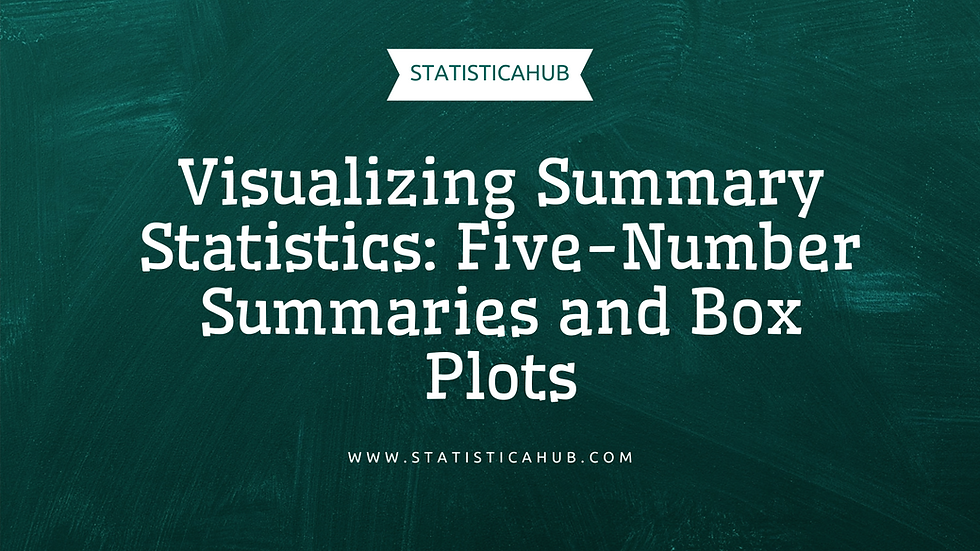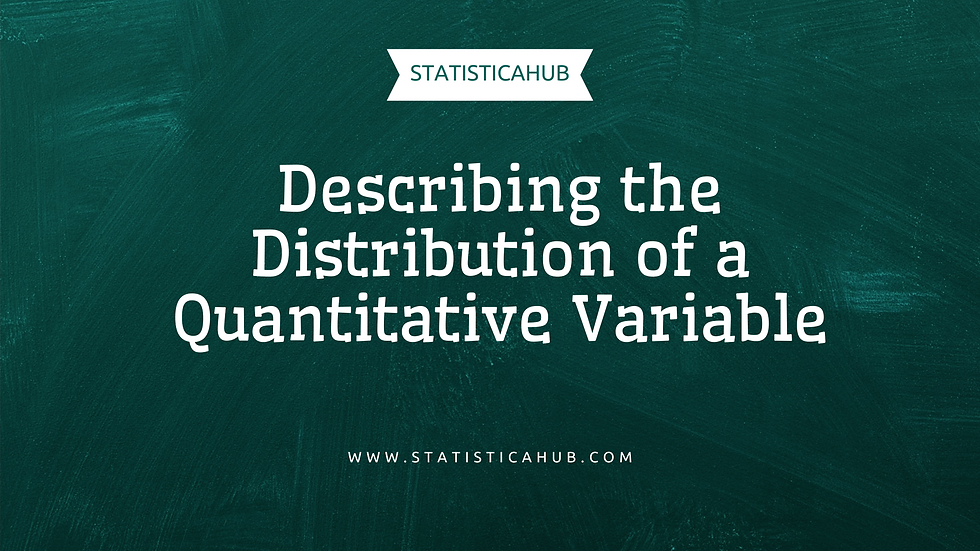1.7 Summary Statistics for a Quantitative Variable
- StatisticaHub

- Dec 9, 2024
- 3 min read
AP Statistics: Exploring one variable data

In statistics, summary measures play a pivotal role in understanding and interpreting data. A statistic is a measure derived from a sample, helping us analyze the dataset, whereas a parameter refers to a measure from the entire population. In inferential statistics, we use sample statistics to make educated inferences about population parameters. This guide delves into summary statistics, particularly focusing on quantitative variables.
Overview of Summary Statistics
Summary statistics are classified into two main categories:
Measures of Central Tendency: These describe the center or typical value of a dataset (e.g., mean, median, and mode).
Measures of Spread: These quantify the variability or dispersion of the data (e.g., range, interquartile range (IQR), and standard deviation).
These measures, though simple in concept, are critical for effectively summarizing and interpreting quantitative data. However, their utility may vary depending on the nature of the data distribution.
Measures of Central Tendency
The Mean
The mean, commonly referred to as the average, is calculated by summing all data points and dividing by the total number of observations.

Strengths: The mean incorporates all data points, making it a reliable summary for symmetric distributions.
Limitations: It is sensitive to outliers, which can significantly skew its value. For instance, a single extreme value can disproportionately increase or decrease the mean, potentially leading to misleading conclusions.
The Median
The median is the middle value when the dataset is ordered. For datasets with an even number of observations, it is the average of the two central values. The median is particularly useful for skewed distributions or datasets with outliers because it remains unaffected by extreme values.
How to Find the Median:

Median Calculation
Mean vs. Median
For symmetric, unimodal distributions, the mean is preferred as it captures the balancing point of the distribution.
For skewed distributions or those with outliers, the median is a more robust measure of central tendency.
Rule of Thumb:
Right-skewed distributions: Mean > Median
Left-skewed distributions: Mean < Median
Reporting both mean and median can provide a comprehensive understanding of the data's central tendency, especially if the two measures differ.
Measures of Spread
Standard Deviation (SD)
The standard deviation quantifies how data points deviate from the mean. Its formula for a sample is:

Here, n−1 adjusts for the sample's degrees of freedom, providing an unbiased estimate of population variance.
Strengths: A versatile measure for symmetric datasets, providing insight into the average deviation from the mean.
Limitations: Sensitive to outliers and less effective for skewed distributions.
Interquartile Range (IQR)
The IQR measures the spread of the middle 50% of data points, calculated as:
IQR= Q3 - Q1
Where:
Q1: The first quartile (25th percentile).
Q3: The third quartile (75th percentile).
Strengths: Resistant to outliers, making it ideal for skewed datasets.
Limitations: Does not account for the entire dataset.
Range
The range is the simplest measure of spread, defined as the difference between the maximum and minimum values:
Range=Max−Min
However, it is highly sensitive to outliers and does not reflect variability within the dataset.
Outlier Detection
Outliers are data points that deviate significantly from other observations. Identifying and addressing them is crucial for accurate analysis. Common methods include:
1.5 × IQR Rule:

Lower and Upper Fence Standard Deviation Method:
Outliers are values more than 2 standard deviations from the mean.
Resistant vs. Non-resistant Measures
Non-resistant Measures: Mean, standard deviation, and range. These are influenced by outliers.
Resistant Measures: Median and IQR. These remain robust against extreme values.
Key Takeaways
For symmetric datasets: Report the mean and standard deviation.
For skewed datasets: Report the median and IQR.
Always include units for clarity and context.
Key Vocabulary
Mean: Average value.
Median: Middle value.
Range: Spread between maximum and minimum values.
IQR: Middle 50% range of data.
Standard Deviation: Average deviation from the mean.
By understanding and correctly applying these summary statistics, you can effectively describe and analyze quantitative data, providing valuable insights into its characteristics. Always consider the distribution and context of your data when choosing the appropriate measures.




Kommentare